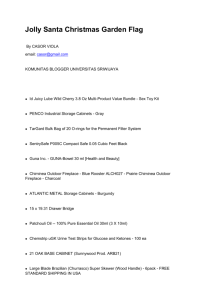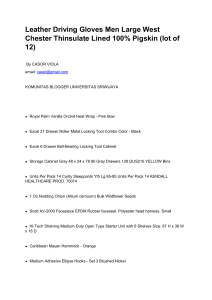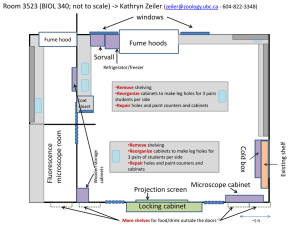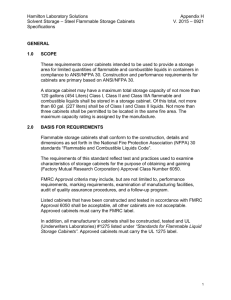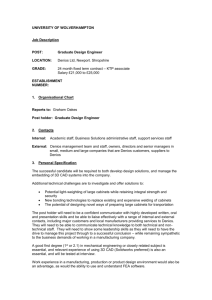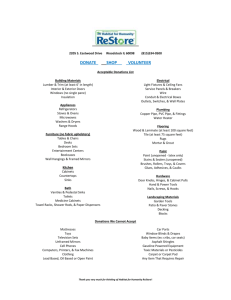Storage Cabinets
advertisement
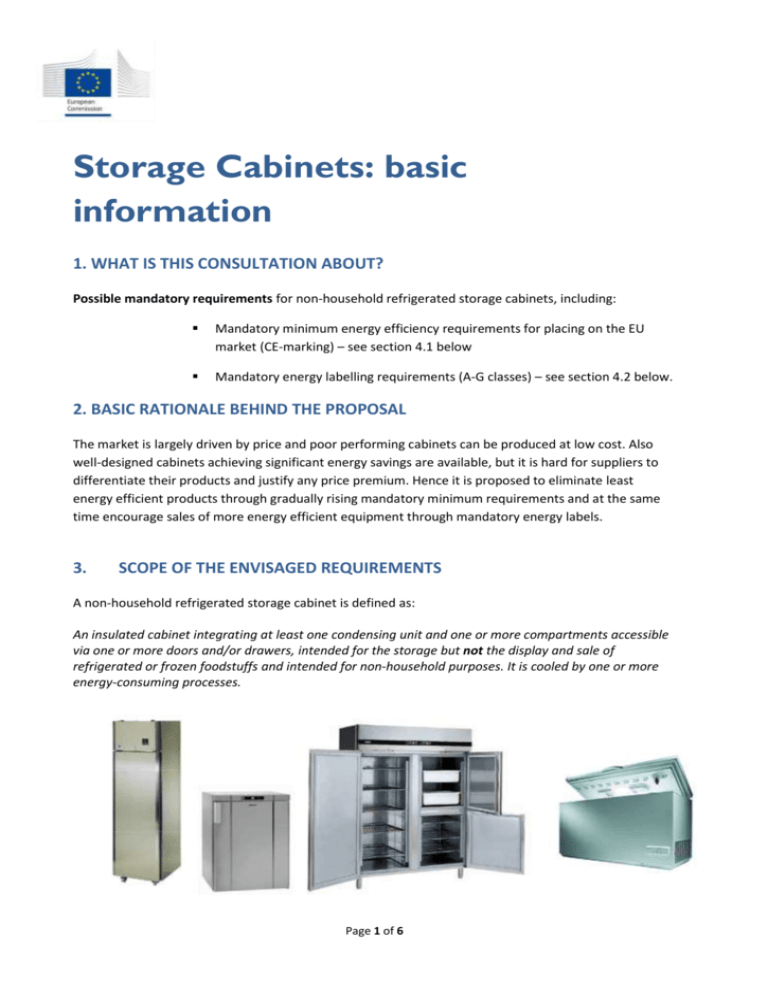
Storage Cabinets: basic information 1. WHAT IS THIS CONSULTATION ABOUT? Possible mandatory requirements for non-household refrigerated storage cabinets, including: Mandatory minimum energy efficiency requirements for placing on the EU market (CE-marking) – see section 4.1 below Mandatory energy labelling requirements (A-G classes) – see section 4.2 below. 2. BASIC RATIONALE BEHIND THE PROPOSAL The market is largely driven by price and poor performing cabinets can be produced at low cost. Also well-designed cabinets achieving significant energy savings are available, but it is hard for suppliers to differentiate their products and justify any price premium. Hence it is proposed to eliminate least energy efficient products through gradually rising mandatory minimum requirements and at the same time encourage sales of more energy efficient equipment through mandatory energy labels. 3. SCOPE OF THE ENVISAGED REQUIREMENTS A non-household refrigerated storage cabinet is defined as: An insulated cabinet integrating at least one condensing unit and one or more compartments accessible via one or more doors and/or drawers, intended for the storage but not the display and sale of refrigerated or frozen foodstuffs and intended for non-household purposes. It is cooled by one or more energy-consuming processes. Page 1 of 6 This includes the following categories: Category VC: Vertical chilled cabinets Category VF: Vertical freezer cabinets Category HC: Counter, horizontal and under-counter chilled cabinets Category HF: Counter, horizontal and under-counter freezer cabinets Category FF: Fridge freezer cabinets Category CHEST: Non-household chest freezers. It is envisaged that the same requirements will apply to storage cabinets with transparent doors (which are intended for the storage, but not the sale and display of foodstuff, and are therefore usually located in storage areas, back shops, professional kitchens etc and not in retail areas). See question 7. Excluded from the scope: Cabinets operating with a remote condensing unit; open cabinets; open top preparation tables and saladettes; cabinets that carry out food processing and not just storage function (e.g. bakery cabinets that chill, heat and humidify); serve-over counters and any other form of cabinet primarily intended for display and sale of foodstuff. See Question 2.1 Special provisions and exemptions Built-in, roll in and roll-through cabinets and fridge freezers , See Question 2.2 Non-household static air cabinets would be submitted to the labelling and minimum energy efficiency requirements of household refrigerators from January 2016. See Question 2.3 Non-household chest freezer cabinets would be submitted to the labelling and minimum energy efficiency requirements of household refrigerators from July 2014. See Question 2.4 Please see precise definitions of all these specific types of cabinets in Annex 1 4. ENVISAGED REGULATORY REQUIREMENTS 4.1 PROPOSED ECODESIGN REQUIREMENTS FOR CATEGORIES VC, VF, HC AND HF Requirements Date of entry into ENERGY EFFICIENCY application INDEX (EEI) Comment Tier 1 1 year after legal entry into force (January 2015) EEI < 125 = Phase out of Class G Tier 2 2 years after legal entry into force EEI < 110 = Phase out of Page 2 of 6 (January 2016) Tier 3 Class F 4 years after legal entry into force (January 2018) EEI < 100 = Phase out of Class E NB. This may be applied equally to models with transparent doors – See Question 7. 4.2 LABELS All non-household storage cabinets falling in the scope of the definition above must have a designated EU energy label from July 2014. The energy label A-G will be broadly similar in size and format to the usual EU household appliance energy label. Additional classes (A+, A++, A+++) above class A would be introduced in subsequent years, and lowest classes are removed so that the label retains no more than 7 label classes (please see pictures and explanations in Annex 1). Suppliers shall provide a printed energy label with each cabinet in accordance with the regulation and publicly accessible information about the energy labelling class of each cabinet. Dealers (and/or suppliers where appropriate) shall ensure that storage cabinets are always presented with the right energy label at the point of sale. The energy class of the model has to be included in catalogues or any other promotional material describing the technical features of the product, as well as in advertisement including energy-related and price information. FOR CATEGORIES HC, HF, VC AND VF Energy label class A+++ A++ A+ A B C D E F G EEI EEI < 18 18 < EEI < 28 28 < EEI < 40 40 < EEI < 55 55 < EEI < 75 75 < EEI < 90 90 < EEI < 100 100 < EEI < 110 110 < EEI < 125 EEI > 125 Start date for mandatory inclusion on labels (Note: Classes are allowed to be displayed before this date) January 2018 January 2016 January 2015 July 2014 July 2014 July 2014 July 2014 July 2014 July 2014 July 2014 Page 3 of 6 Date from which class shall not appear on labels (Note: Classes are allowed to be omitted before this date) January 2018 January 2016 January 2015 5. CALCULATION AND MEASUREMENT For more details on calculation and measurement, please see Annex 1: Summary of Envisaged Requirements and Test Method (available in English only). 5.1 CALCULATION OF THE ENERGY EFFICIENCY INDEX (EEI) The EEI is the ratio between the Annual Energy Consumption of the specific model (usually measured through testing) and a Standard Annual Energy Consumption calculated from a formula using the volume of the specific cabinet (see below). EEI is expressed as a percentage. EEI AEC 100 SAEC Where AEC=E24h ×365 With AEC = Annual Energy Consumption of the cabinet in kWh/year E24h = energy consumption of the cabinet over 24 hours And SAEC= M × Vn +N With SAEC = Standard Annual Energy Consumption of the cabinet in kWh/year Vn = net volume of the appliance, which is the sum of net volumes of all compartments of the cabinet. The net volume is defined as the volume containing foodstuffs within the load limit, minus the volume of shelves and any internal fittings. It is measured as indicated in standard EN4411. For fridge freezers, the net volume is replaced by the adjusted net volume VA = Vn,ref + Vn,frz × 1.92 Where 1 Vn,ref is the sum of the net volume of all chilled compartments in litres Vn,frz is the sum of the net volumes of all freezer compartments in litres See section 3.7 of EN 441‐1: 1995. EN 441 has been superseded, but the replacement (EN23953) does not provide an adequate definition for net volume the purpose of this regulation. Page 4 of 6 The factor 1.92 is from a standard thermodynamic ratio which provides the volume of refrigerator compartment that consumes the same energy as a unit volume of the freezer compartment. M and N are given in the table below Category Value for M Value for N Vertical Chilled (VC) 1.643 609 Vertical Frozen (VF) 4.928 1472 Horizontal, counter and under-counter Chilled (HC) 2.555 1790 Horizontal, counter and under-counter Frozen (HF) 5.840 2380 Note: Values would have been given for fridge-freezers but insufficient evidence is available at present to set robust requirements. This is under review. 5.2 WHAT IS THE TEST METHOD FOR MEASURING ENERGY CONSUMPTION? It is expected that the measurement method will be similar to that developed by CECED Italia2 and based on EN ISO 23953-2:2006 with the following features: Storage temperatures M1 (chilled) or L1 (frozen); ambient conditions to be Climate Class 4 (+30°C and 55% relative humidity); 48-hour duration for the test; cabinet to be loaded as indicated in EN23953 (i.e. positioning of the M-packages inside the cabinet during the test); door openings to follow the CECED Italia methodology (http://www.ceceditalia.it/servlet/poba_bwffile?p_NodoID=6138). The test methodology will be published by the end of 2013 at the latest. 2 This methodology is available from http://www.ceceditalia.it/servlet/poba_bwffile?p_NodoID=6138 Page 5 of 6 6. WHAT SHALL BE DECLARED WHEN PLACING THE PRODUCT ON THE EU MARKET? From 1 July 2014, the following parameters shall be reported in the product documentation: The intended use for storage (not display) of foodstuff the declared category of the appliance according to the definitions of this regulation (e.g. horizontal chilled cabinet, roll-in freezer cabinet, static air cabinet, semi-professional, etc.) . Indication of any restriction on the product’s intended usage (e.g. semi-professional cabinets are not appropriate for use in hot kitchens) Net storage volume in litres and rounded to one decimal place. For refrigerator-freezer models, the chilled net volume, the freezer net volume and the adjusted net volume shall be declared in litres Declared annual energy consumption in kWh per year to the nearest whole unit Declared Energy Efficiency Index and associated energy label class Explanation for users of how to minimise the energy consumption of the cabinet Useful links: European Commission http://ec.europa.eu/enterprise/ecodesign CECED Italia – the Italian trade association which has developed its own voluntary energy labelling scheme with an associated test methodology www.ceceditalia.it Page 6 of 6
